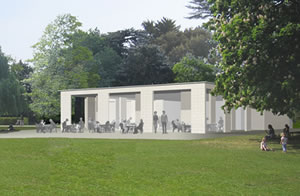Archaeological Dig Reveals Site History
As work begins on a brand new café at Chiswick House
Work starts this week on a brand new café at Chiswick House and Gardens. The new building, constructed partly of Portland Stone, will be a relaxing, modern space for visitors to the park to use and enjoy. The new café will open in Spring 2010 following the completion of the garden restoration works.
The new café will be south facing and so will be in a warmer, lighter position than the old building. It will have a colonnade across its main elevation which will provide a covered external seating area from which people can enjoy views of the park. The room will be extensively glazed so that the garden can be fully appreciated. New lawns will be created on the site of the old café and Old Burlington Lane will be straightened to a line closer to its original route.
The new design looks at the building and surrounding landscape very much as a unified whole. In William Kent’s design for Chiswick House Gardens, white classical pavilions are framed by a carefully composed informal landscape of mature trees. In an equivalent way the new café and its surrounding landscape have been considered together.
The old café building has now been closed and will be demolished. Whilst work on the new café is taking place a temporary refreshment kiosk has opened near the cricket pavilion at the Staveley Road entrance to the Gardens. The toilet block near this entrance been repaired, cleaned and re-opened.
Archaeological Dig Reveals History of New Café Location
In preparation for the construction of the new café building, a team of experts from English Heritage carried out archaeological excavations which uncovered a number of new findings.
Two trenches were excavated close to the old café, the first of which is located over a complex sequence of structural remains of a 17th century Service Building and the second trench is located to the south-east of the Summer Parlour.
Dave Fellows, Archaeologist for English Heritage, said: “The excavations have surpassed our expectations. We have uncovered a wealth of information that will enhance our understanding of the archaeological sequence of this extremely important part of the site. We have discovered the well-preserved footings of the 17th-century Service Building, and have found a great deal of evidence for its use; this ranges from part of the building used for stabling, to a large brick vaulted cellar beneath the northern end of the building.
We have also excavated yard surfaces, paths and planting beds from earlier garden designs, including beds from an early 17th century Knot Garden. Work is now underway to analyse the information retrieved and to work towards publishing the results of the excavation.”
August 11, 2008
Related links
|
